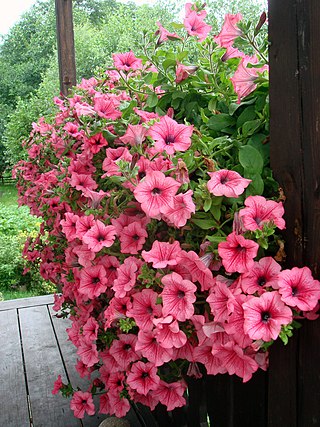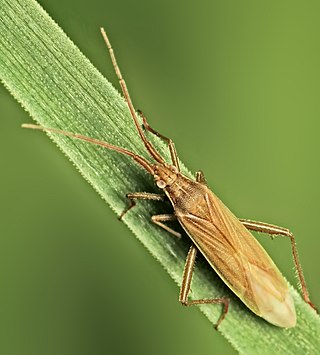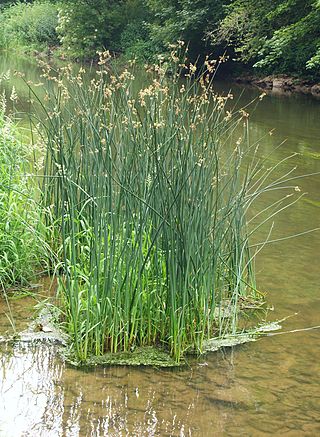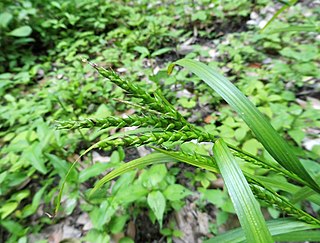
The Poales are a large order of flowering plants in the monocotyledons, and includes families of plants such as the grasses, bromeliads, and sedges. Sixteen plant families are currently recognized by botanists to be part of Poales.

Ornamental plants or garden plants are plants that are primarily grown for their beauty but also for qualities such as scent or how they shape physical space. Many flowering plants and garden varieties tend to be specially bred cultivars that improve on the original species in qualities such as color, shape, scent, and long-lasting blooms. There are many examples of fine ornamental plants that can provide height, privacy, and beauty for any garden. These ornamental perennial plants have seeds that allow them to reproduce. One of the beauties of ornamental grasses is that they are very versatile and low maintenance. Almost any types of plant have ornamental variety/varieties: trees, shrubs, climbers, grasses, succulents, aquatic plants, herbaceous perennials and annual plants. Non-botanical classifications include houseplants, bedding plants, hedges, plants for cut flowers and foliage plants. The cultivation of ornamental plants comes under floriculture and tree nurseries, which is a major branch of horticulture.

Herbaceous plants are vascular plants that have no persistent woody stems above ground. This broad category of plants includes many perennials, and nearly all annuals and biennials.

The Cyperaceae are a family of graminoid (grass-like), monocotyledonous flowering plants known as sedges. The family is large, with some 5,500 known species described in about 90 genera, the largest being the "true sedges" genus Carex with over 2,000 species.

Juncaceae is a family of flowering plants, commonly known as the rush family. It consists of 8 genera and about 464 known species of slow-growing, rhizomatous, herbaceous monocotyledonous plants that may superficially resemble grasses and sedges. They often grow on infertile soils in a wide range of moisture conditions. The best-known and largest genus is Juncus. Most of the Juncus species grow exclusively in wetland habitats. A few rushes, such as Juncus bufonius are annuals, but most are perennials.

A forb or phorb is a herbaceous flowering plant that is not a graminoid. The term is used in biology and in vegetation ecology, especially in relation to grasslands and understory. Typically these are dicots without woody stems.
Sedges, Cyperaceae, are a family of graminoid (grass-like) flowering plants named for the saw-like edges of their leaves.

Ornamental grasses are grasses grown as ornamental plants. Ornamental grasses are popular in many colder hardiness zones for their resilience to cold temperatures and aesthetic value throughout fall and winter seasons.

Agrostology, sometimes graminology, is the scientific study of the grasses. The grasslike species of the sedge family (Cyperaceae), the rush family (Juncaceae), and the bulrush or cattail family (Typhaceae) are often included with the true grasses in the category of graminoid, although strictly speaking these are not included within the study of agrostology. In contrast to the word graminoid, the words gramineous and graminaceous are normally used to mean "of, or relating to, the true grasses (Poaceae)".
A ligule is a thin outgrowth at the junction of leaf and leafstalk of many grasses (Poaceae) and sedges. A ligule is also a strap-shaped extension of the corolla, such as that of a ray floret in plants in the daisy family Asteraceae.

The Eriocaulaceae are a family of monocotyledonous flowering plants in the order Poales, commonly known as the pipewort family. The family is large, with about 1207 known species described in seven genera. They are widely distributed, with the centers of diversity for the group occurring in tropical regions, particularly the Americas. Very few species extend to temperate regions, with only 16 species in the United States, mostly in the southern states from California to Florida, only two species in Canada, and only one species in Europe. They tend to be associated with wet soils, many growing in shallow water. This is also reported from the southern part of India and the regions of Western Ghats hot spots.

Rhynchospora alba, the white beak-sedge, is a plant in the sedge family, Cyperaceae. It is a tufted herbaceous perennial around 50 cm tall, with white inflorescences that flower in August. The fruit of the sedge is a small achene with a characteristic beak-like cap. It is dispersed by wind or falls by gravity, leading to individuals existing in tight clumps. The species favours wet, acidic and nutrient poor soils, thriving in Sphagnum-dominated bogs, but also peaty grasslands. As such it is often used as a positive indicator for bog and mire ecosystem health.

Nabis flavomarginatus is a species of damsel bug in the family Nabidae.

Stenodema calcarata is a species of bug from Miridae family, that can be found in Europe and across the Palearctic to Central Asia, the Russian Far East, Siberia, northern China, Korea and Japan.

Bulrush is a vernacular name for several large wetland grass-like plants

Juncus dichotomus is a monocot in the Juncaceae family of rushes. The plant is native to the Americas in temperate zones but has been introduced to other parts of the world. Juncus dichotomus often is found in very moist areas and where rainfall is a common occurrence. It is often most recognizable in the spring and summer months due to its conspicuous flowers and infructescence.

Carex albicans, commonly called whitetinge sedge, is a species of flowering plant in the sedge family (Cyperaceae). It is native to the eastern North America, where it is found in Canada and the United States. Its typical natural habitat is dry forests and woodlands.

Carex ischnostachya is an herbaceous graminoid plant in the sedge family (Cyperaceae). It is native to the eastern Asia, where it is found in China, Japan, and Korea. Its natural habitat is in forest openings in wet areas, in hills or mountains. It is a common species, and is often found along roadsides or trails.



















